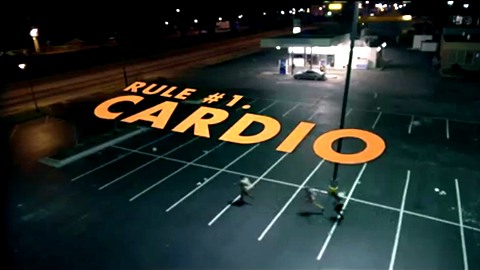Survival School: Sweat or Death?
Sweat or death? The answer should be easy. Unfortunately, the vast majority of people are “too busy,” “don’t have enough time,” “don’t know what to do,” or simply don’t want to put the effort into getting into shape. Getting over the mental barrier keeping you from working out is possibly the most difficult part. We’re here with a nice, simple mantra to get brigadiers out of their office chairs and into a healthy exercise routine. Are you ready for it? Here goes . . . .
Get in shape or get eaten.
Told you guys it was simple.
Yes, it seems silly. Everyone knows zombies, if they ever do exist, will probably be slow and clumsy. But there may be a lot of them. In large numbers, it’ll be easier for them to corner someone who’s out of breath from running less than a block. Not to mention, there is always the unsavory reality that the humans in the zombie apocalypse pose the true danger—we don’t want anyone winding up like the poor souls in the cages at Terminus during the season 4 finale of “The Walking Dead.” Staying one step ahead of an intelligent threat requires more than a few sit-ups once a month. Survival also means more than defeating anyone seeking to harm you. Gathering food, water, firewood, and building a secure base camp will require more strength than most people possess without at least a little training.
Disclaimer: This article is intended to provide basic guidelines and motivation to get you started on a healthy workout path. If you have health issues, please consult a doctor before beginning any exercise routines.
The CDC—using the 2008 Physical Activity Guidelines for Americans—recommends adults between the ages of 18 to 64 do medium-intensity aerobic exercise for a minimum of 150 minutes per week, or half as much high-intensity aerobic exercise (75 minutes). Plus, 2 days of muscle strengthening activities per week on top of the aerobic exercise.
The main goal of aerobic exercise is to raise your heart rate for longer than 10 minutes at a time throughout the day. That’s a handful of laps in the pool. A couple miles on a stationary or standard bike. A brisk mile walk around your neighborhood. Heck, even a quick 3-song dance break in your closed office or an afternoon of gardening. For more ideas, here’s the CDC’s guide for measuring physical activity intensity.
Muscle strengthening activities are pretty self-explanatory. Biceps and shoulder muscles—which you need to cut down firewood and the undead—won’t build themselves while you watch just one more episode of your favorite show (do like we do, watch TV while working out). Strong abdominal and back muscles can cut down on back problems that’d put you out of commission, unable to find food on your own.
2 days a week, after your aerobic exercise is done, work your muscles head to toe. This can be done with weight lifting, resistance band exercises (good for those rebuilding muscle after injury), yoga, or body weight exercises—planks, the Superman exercise, push-ups, crunches, etc. It’s okay to alternate days to focus mainly on arms or legs, but work every muscle every time. There’s numerous resources on the internet to find exercises that’ll work best for your body. Take the time to create a routine and once you’re comfortable, begin to adapt it to up the reps and weight, or work new muscle groups.
Don’t forget to breathe! Muscles need oxygen. Holding your breath to push through one last rep will only starve your muscles.
Lastly, wrap up every exercise break with stretching. It’ll ease some post-workout soreness and ensure you remain flexible, able to move quickly and dodge those pesky zombies.

